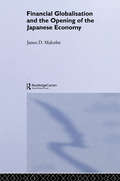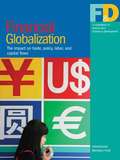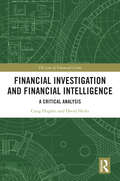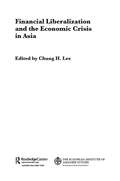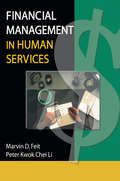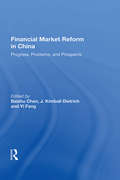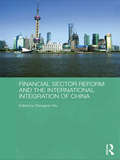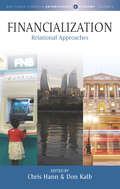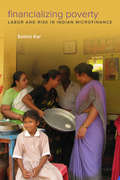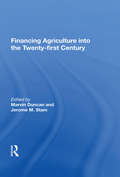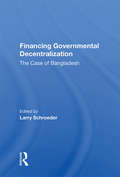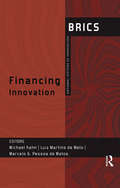- Table View
- List View
Financial Fragility and Instability in Indonesia (Routledge Contemporary Southeast Asia Series #2)
by Yasuyuki MatsumotoThis highly relevant study provides an incisive analysis of a critical phase in recent East Asian financial history, exploring the underlying causes of the financial crisis that struck Indonesia during the second half of 1997. Matsumoto’s extensive commercial experience in Indonesian finance during these critical years, allows him to skilfully argue that the roots of the crisis lay in the period of capital liberalization undertaken during the boom years from 1994 to 1997 which encouraged the development of fragile and unstable financial structures, involving increased corporate leverage, reliance on external debt, and the introduction of riskier and more complicated financial instruments and transactions. In-depth fieldwork data and four detailed case studies illuminate the microeconomic foundations of the crisis, showing how Indonesian capitalists sought to liquidate their Indonesian assets without losing control of their corporate empires, by taking advantage of increased access to foreign loans and complex financial re-engineering, actions which ultimately precipitated instability and crisis throughout the entire financial system. Finally, it reflects upon the policy implications of this episode, putting forward the case for comprehensive capital controls for open and developing economies until they establish appropriate financial institutions to monitor and manage the level of indebtedness and the volatility of capitalists’ behaviour.
Financial Globalization and the Opening of the Japanese Economy
by James P. MalcolmThis book investigates recent changes in Japan's financial system and looks at the implications for Japan's particularistic model of political economy. Drawing on the latest theoretical research, it seeks to determine how Japan's experience resembles patterns which many scholars in the West have associated with financial globalization as a powerful force for conveyance. The book sets out the background and examines the progression of financial deregulation in Japan, culminating in the Big Bang programme of financial reform set in motion in November 1996. It analyses developments in the financial sector to gauge the extent to which Japanese financial institutions are falling into line with emerging norms of organization and strategic management. It also examines the implications for the corporate and household sectors stemming from the government and financial sectors' partial embrace of financial globalization.
Financial Globalization: A compilation of articles from Finance & Development
by International Monetary FundA report from the International Monetary Fund.
Financial Governance in East Asia: Policy Dialogue, Surveillance and Cooperation (Routledge Studies in the Growth Economies of Asia #Vol. 51)
by Gordon De Brouwer Yunjong WangThe focus of international financial reform in recent years has largely been at the global level, in terms of improving the international financial architecture, and at the national level in terms of getting domestic economic and structural policies right. But there is also a growing appetite for addressing some issues at a regional level. This debate has focused on improving regional policy dialogue and surveillance processes, as well as developing regional mechanisms to provide financial support to prevent and resolve financial crises. In East Asia, for example, governments have sought deeper regional policy dialogue by the creation of ASEAN+3 forum and enhanced financial cooperation by setting up the Chiang Mai Initiative. These developments raise many questions: What is 'best-practice' regional policy dialogue? How is a regional financial architecture complementary to the global architecture? What sorts of institutions work well at a regional level? Do regions need a regional monetary fund? What is going on in East Asia and how is it different to other regions? This volume brings together a range of policy, practical and conceptual papers to explore these and other issues.
Financial Instruments to Hedge Commodity Price Risk for Developing Countries
by Yinqiu Lu Salih NeftciA report from the International Monetary Fund.
Financial Investigation and Financial Intelligence: A Critical Analysis (The Law of Financial Crime)
by Craig Hughes David HicksThis book critically analyses the conceptual understanding of financial investigation and financial intelligence among UK law enforcement authorities and their commentators. The work provides a critical review of financial investigation, including international standards, and how it is perceived and applied by law enforcement agencies. It adopts the position that financial investigation is an evidence-gathering process and not simply related to asset recovery. Here, the concept of “following the money” is superseded by the wider approach of “following the financial footprint” by generalist and specialist investigators and analysts. The book focuses on identifying the financial footprint as a skill set for routine investigation application inclusive of the emerging threat posed by the digital environment, including cryptocurrencies. It assesses the terminology, typologies and structures associated with the subject area at the national and international levels. It also examines the historical trajectory of financial investigation to understand current perceptions of it within law enforcement, among government ministers and policy makers. The book will be of interest to students, academics and policy makers internationally working in the areas of criminal law, criminology and finance.
Financial Liberalization and the Economic Crisis in Asia (European Institute of Japanese Studies East Asian Economics and Business Series)
by Chung H. LeeWhat brought about a financial crisis in the "miracle" economies of Asia? What went wrong with financial reform in Asia? What can the developing countries of the world learn from the reform experiences in Asia?Financial Liberalization and the Economic Crisis in Asia analyses how financial liberalization was undertaken in eight Asian countries and how it might be linked to the subsequent crises. The country studies focus on China, India, Indonesia, Japan, Malaysia, the Philippines, South Korea and Thailand.
Financial Management and Corporate Governance from the Feminist Ethics of Care Perspective
by Desi Adhariani Nick Sciulli Robert CliftThis book investigates how businesses can adapt their executive and fiscal practices to adopt an ethical, equal-opportunity approach. The authors demonstrate how corporations can create sustainable work environments that embrace feminist care ethics and ground their research in a strong theoretical discussion of this relatively new framework. The discussion has a multidisciplinary outlook and explores how the concept of care ethics might be successfully applied to various professional contexts. Later chapters present findings from an empirical case study conducted in Australia and use both qualitative and quantitative methods to analyse the potential power of a feminist care of ethics approach within commercial and corporate management.
Financial Management for Nonprofit Human Service Organizations (Second Edition )
by Raymond Sanchez MayersThis book is an update of the previous edition, formerly titled Financial Management for Nonprofit Human Service Agencies. This new and expanded edition provides the critical knowledge needed to communicate with the "experts." The central organizing theme of this book is the acquisition, distribution, and reporting of agency resources within a systems framework. New topics include fees for services, purchase of service contracting, breakeven analysis for costing services and activities, third-party payments, internet resources, and a glossary.
Financial Management in Human Services
by Marvin D Feit Peter K LiRather than treating financial management as an independent administrative practice, Financial Management in Human Services provides students and social service administrators with a conceptual framework in which financial management is the major responsibility of an administration, not just a separate practice. This text describes how the integration of administrative practice with fiscal responsibility and accountability will help you plan better programs, account for all fiscal transactions, and coordinate and evaluate services more effectively.Containing many different approaches on how to determine costs, obtain information, and collect data, this text will help you clearly evaluate your organization’s progress and determine if your program goals are being reached. Financial Management in Human Services also discusses other topics related to efficient management, including: applying financial management techniques to the areas of program planning, service monitoring, estimating service and unit costs, and setting future service priorities in order to make better business decisions utilizing the information generated from the Financial Management System (FMS) to improve administrative functions, such as forecasting and goal determination, activity flow and service provision monitoring, and service planning according to program policy examining the importance of the four administrative subsystems-- budgeting and accounting, service coordination, program planning, and program evaluation choosing a FMS with consideration to certain factors, such as availability of information and identifying informational needs of the administration listing of reactive and proactive types of financial reports that help administrators evaluate the costs of services provided and identify problems in balancing the fiscal budget using methods such as a line item analysis to accurately compute the costs of staff involvement in a programThis organized, straightforward text will help you evaluate all costs-- from salaries, travel time, and office supplies to direct costs to make your office more organized and productive. Complete with questions and answers about starting and maintaining a FMS, Financial Management in Human Services will enable you to manage finances more efficiently, making it easier for you to reach and set goals that better serve your clients.
Financial Market Reform In China: Progress, Problems, And Prospects
by Baizhu ChenAs editors, first of all, we would like to thank the authors of this volume for their conscientious work that makes this volume possible. Many ideas in this book were first explored at an international symposium on financial market reforms in China, which was organized by the Chinese Economists Society. We would like to express our thanks to the sponsors of the conference: Center for International Business Education and Research, China Reform Foundation, MetLife, Hausman & Shrenger LLP, Lincoln National Insurance Company, City National Bank, Marshall School of Business, University of Southern California and The Chinese Economists Society. The Lincoln Foundation also provided generous support to this project through a grant made to Claremont Graduate University where this book was finalized.
Financial Sector Reform and the International Integration of China (Routledge Studies on the Chinese Economy)
by Zhongmin WuChina's economy, which continues to grow rapidly, is having an ever greater impact on the rest of the world. This impact is likely to be felt increasingly in the financial sector where China's foreign currency reserves, fuelled by the huge trade surplus, are a very significant factor in world financial markets. This book, based on extensive original research by a range of leading experts, examines many key aspects of current reforms in China's financial sector and China's increasing integration into the international economy. Subjects covered amongst many others include: the derivatives market in China; stock market liberalisation; the internationalization of accounting standards in China; the impact of international foreign direct investment by Chinese firms; and a discussion of the likely long-term economic effects of the Beijing Olympic Games.
Financial Spillovers to Emerging Markets During the Global Financial Crisis
by Nathaniel Frank Heiko HesseA report from the International Monetary Fund.
Financial Statements Analysis: Cases from Corporate India
by Sandeep GoelFinancial analysis is integral to business sustainability in determining an organisation’s financial viability and revealing its strengths and weaknesses, a key requirement in today’s competitive business environment. In a first of its kind, Financial Statements Analysis: Cases from Corporate India: evaluates the financial performance and efficiency of various corporate enterprises in India; presents actual case studies from eight core sectors (in manufacturing and services) — construction, cement, steel, automobile, power, telecom, banking, and Business Process Outsourcing (BPO); examines the financial statements on parameters such as financial ratios (profitability, solvency, and liquidity), while appraising their operating efficiency, market potential and valuation; and investigates their implications for larger decision-making and policy recommendations. It will be an important resource for scholars, teachers and students of business and management, commerce, finance, and accounting. It will also appeal to corporate trainers, senior executives and consultants in related fields.
Financial Technology and the Law: Combating Financial Crime (Law, Governance and Technology Series #47)
by Doron Goldbarsht Louis De KokerBlockchains and cryptocurrencies, open banking, virtual assets, and artificial intelligence have become the buzzword of this decade. This book focuses on these ‘disruptive’ financial technologies that provide alternatives to the traditional financial services typically offered by regulated financial institutions. Financial technologies are characterized by the innovative ways in which they initiate, support or extend traditional financial services or offer alternative financial pathways and products. However, these financial technologies also pose money laundering and terrorist and proliferation financing as well as cyber security risks that require mitigation. This edited volume addresses a range of regulatory and enforcement challenges related to financial technology and financial crime. The book responds to the United Nations’ Sustainable Development Goals, in particular in relation to economic development, employment, national security, law enforcement and social well-being. Fostering responsible financial innovation promotes long-term economic growth, inclusion, and improved living standards. This book explores how to promote financial innovation while mitigating risks in a way that ensures financial prosperity and social inclusion.
Financial Vipers of Venice
by Joseph P. FarrellIn this sequel to Babylon's Banskters. The banksters have moved from Mesopotamia via Rome to Venice. There, they have manipulated popes and bullion prices, clipped coins, sacked Constantinople, destroyed rival Florence, waged war, burned "heretics" and suppressed hidden secrets threatening their financial supremacy... until Giordano Bruno and Christopher Columbus, broke the banking cartel's control of information and bullion...
Financialization: Relational Approaches (Max Planck Studies in Anthropology and Economy #6)
by Don Kalb Chris HannBeginning with an original historical vision of financialization in human history, this volume then continues with a rich set of contemporary ethnographic case studies from Europe, Asia and Africa. Authors explore the ways in which finance inserts itself into relationships of class and kinship, how it adapts to non-Western religious traditions, and how it reconfigures legal and ecological dimensions of social organization, and urban social relations in general. Central themes include the indebtedness of individuals and households, the impact of digital technologies, the struggle for housing, financial education, and political contestation.
Financializations of Development: Global Games and Local Experiments (Routledge Explorations in Development Studies)
by Ève Chiapello Anita Engels Eduardo Gonçalves GresseFinancializations of Development brings together cutting-edge perspectives on socio-political, socio-historical and institutional analyses of the evolving multiple and intertwined financialization processes of developmental institutions, programs and policies. In recent years, the development landscape has seen a radical transformation in the partaking actors, which have moved beyond just multilateral or bilateral public development banks and aid agencies. The issue of financing for sustainable development is now at the top of the agenda for multilateral development actors. Increasingly, development institutions aim to include private actors and to lever in private money to support development projects. Drawing on case studies conducted in Africa, Asia, Europe and Latin America, this book examines the ways in which these private finance actors are enrolled and associated with the conception and implementation of development policies. Beginning with a focus on global actors and private foundations, this book considers the ways in which development funding is raised, managed and distributed, as well as debates at the center of global forums where financialized policies and solutions for development are conceived or discussed. The book assembles empirical research on development programs and demonstrates the social consequences of the financializations of development to the people on the ground. Highlighting the plurality of processes and outcomes of modern-day relations, tools, actors and practices in financing development around the world, this book is key reading for advanced students, researchers and practitioners in all areas of finance, development and sustainability.
Financializing Poverty: Labor and Risk in Indian Microfinance (South Asia in Motion)
by Sohini KarMicrofinance is the business of giving small, collateral-free loans to poor borrowers that are paid back in frequent intervals with interest. While these for-profit microfinance institutions (MFIs) promise social and economic empowerment, they have mainly succeeded at enfolding the poor—especially women—into the vast circuits of global finance. Financializing Poverty ethnographically examines how the emergence of MFIs has allowed financial institutions in the city of Kolkata, India, to capitalize on the poverty of its residents. This book reveals how MFIs have restructured debt relationships in new ways. On the one hand, they have opened access to new streams of credit. However, as the network of finance increasingly incorporates the poor, the "inclusive" dimensions of microfinance are continuously met with rigid forms of credit risk management that reproduce the very inequality the loans are meant to alleviate. Moreover, despite being collateral-free loans, the use of life insurance to manage the high mortality rates of poor borrowers has led to the collateralization of life itself. Thus the newfound ability of the poor to use MFI loans has entrapped them in a system dependent not only on their circulation of capital, but on the poverty that threatens their lives.
Financing Agriculture Into The Twenty-first Century
by Marvin DuncanThis volume is concerned with the paradigm shifts occurring in U.S. agriculture and its related financial services sector. The U.S. agricultural sector is undergoing rapid change with large segments commonly described as industrialized. Often observers focus on the technological and structural changes that the sector is undergoing and ignore other
Financing China's Rural Enterprises (Chinese Worlds)
by Jun Li Dr Jun LiRural enterprises have played an important role in the extraordinary success of China's economy over the last two decades. They have greatly increased off-farm employment in rural areas and brought substantially increased incomes and standards of living to many rural people. Jun Li provides a comprehensive analysis of the financing of China's rural enterprises over the reform period, and discusses the key aspects of rural enterprise development in China, including the growth of rural enterprises and enterprise-level behaviour, the role of state policy, rural financial institutions and local government. Brings new and challenging analysis to the current debate on the Chinese financial system and the financing of SMEs.
Financing Clean Energy Access in Sub-Saharan Africa: Risk Mitigation Strategies and Innovative Financing Structures (SpringerBriefs in Energy)
by Manfred Hafner Bruno MichoudThis open access book analyses barriers and challenges associated with the financing of clean energy access in sub-Saharan Africa. By considering various economic, financial, political, environmental and social factors, it explores the consequences of energy poverty across the region and maps the real and perceived investment risks for potential capital providers, both domestic and international. Furthermore, it analyses risk mitigation strategies and innovative financing structures available to the public and private sectors, which are aimed at leveraging capital in the clean energy sector at scale and fostering the creation of an enabling business and investment environment.More specifically, the present book analyses how to (i) enhance capital allocation in projects and organisations that foster clean energy access in the region, (ii) mobilize private capital at scale and (iii) decrease the cost of financing through risk mitigation strategies. Going beyond traditional approaches, the book also considers socioeconomic and cultural aspects associated with investment barriers across the subcontinent. Moreover, it urges the public and private spheres to become more actively involved in tackling this pressing development issue, and provides policy recommendations for the public sector, including proposals for business model evolution at multilateral agencies and development institutions. It will appeal to a wide readership of both academics and professionals working in the energy industry, the financial sector and the political sphere, as well as to general readers interested in the ongoing debate about energy, sustainable development and finance.
Financing Governmental Decentralization: The Case Of Bangladesh
by Larry SchroederOne policy goal of many developing countries is to decentralize public sector decision making so as to "bring it closer to the people." While discussions of decentralization commonly focus on how such policies can improve the effectiveness of resource allocation decisions, the issues of from where and how these resources are to become available are
Financing Innovation: BRICS National Systems of Innovation
by Michael Kahn; Luiz Martins de Melo; Marcelo G. Pessoa de MatosThis series of books brings together results of an extensive research programme on aspects of the national systems of innovation in the five BRICS countries – Brazil, Russia, India, China, and South Africa. It provides a comprehensive and comparative examination of the challenges and opportunities faced by these dynamic and emerging economies. In discussing the impact of innovation with respect to economic, geopolitical, socio-cultural, institutional, and technological systems, it reveals the possibilities of new development paradigms for equitable and sustainable growth.This volume analyses the financing of science, technology and innovation in the BRICS economies. It highlights the importance of institutional coordination and the influence of implicit policies on the extent to which capital markets may contribute to innovation financing. It stresses the role of state development banks and similar organisations in promoting high-risk and long-run building of innovative capacities with respect to development strategy. Original and detailed data, together with expert analyses on wide-ranging issues, make this book an invaluable resource for researchers and scholars in economics, development studies and political science, in addition to policy-makers and development practitioners interested in the BRICS countries.
Financing Long-Term Care in Europe
by Joan Costa-Font Christophe CourbageThe ageing of the European population brings new financial risks that call for state, market and societal responses. In 2011, the first baby-boom generation is turning 65, and forecasts predict that the size of the old-age population in need of long-term care will double in the next 50 years in Europe. However, how different countries are responding to the challenge of financing long-term care is still a question open to further examination, including the role of market development, changing intergenerational contracts and especially the constraints of state intervention. Growing long-term care needs in several European countries as well as the reshaping of traditional modes of care-giving further increase the pressure for sustainable funding of more comprehensive long-term care systems. This book examines different forms of partnership and the potential cooperation of state, market and societal stakeholders. It not only offers a full understanding of the institutional responses and mechanisms in place for financing old age but also provides a deep analysis of both the demand and supply factors underpinning the development of financial instruments to cover long-term care needs in Europe. "

